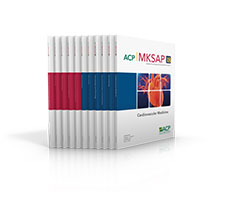 MKSAP has been trusted by internists since 1967 as the best resource for updating knowledge. MKSAP 18, available in Complete, Digital, and Print packages, consists of 11 comprehensive text chapters with related multiple-choice questions. You'll find 1,200 completely new questions to help you identify learning gaps, stay current, and gain the knowledge you need to provide the best possible patient care. MKSAP 18's original and high-quality questions evolve out of case studies and patient scenarios based on the latest evidence.
MKSAP has been trusted by internists since 1967 as the best resource for updating knowledge. MKSAP 18, available in Complete, Digital, and Print packages, consists of 11 comprehensive text chapters with related multiple-choice questions. You'll find 1,200 completely new questions to help you identify learning gaps, stay current, and gain the knowledge you need to provide the best possible patient care. MKSAP 18's original and high-quality questions evolve out of case studies and patient scenarios based on the latest evidence.
For more information on MKSAP 18, or to order your copy, visit mksap18.acponline.org.
MKSAP 18 Q & A
A 35-year-old woman is evaluated for exertional dyspnea of 6 months' duration. She reports no other symptoms. Medical history is unremarkable, and she takes no medications.
On physical examination, vital signs are normal. Oxygen saturation is 96% breathing ambient air. The estimated central venous pressure is elevated. Apical impulse is normal; a parasternal impulse is noted at the left sternal border. A soft systolic murmur is heard at the second left intercostal space, and a diastolic flow rumble is heard at the left sternal border. Fixed splitting of the S2 is noted throughout the cardiac cycle. The remainder of the physical examination is normal.
An electrocardiogram demonstrates right axis deviation and incomplete right bundle branch block.
Which of the following is the most likely diagnosis?
A: Atrial septal defect
B: Bicuspid aortic valve with aortic stenosis
C: Congenital pulmonary stenosis
D: Mitral stenosis
Back to the November 2018 issue of ACP International

